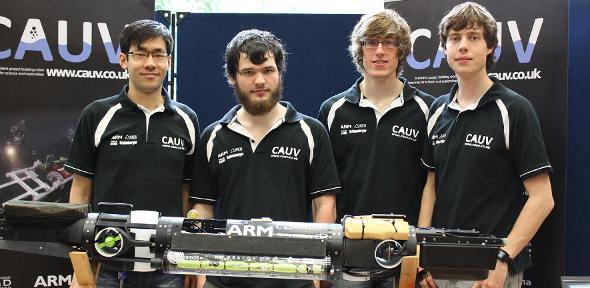
The Cambridge Autonomous Underwater Vehicle (CUAV) team triumphed over 7 other teams to win the 8th Student Autonomous Underwater Vehicle Challenge - Europe.
These young people will always value the lessons learned, the excitement of testing their ideas in a real world ocean environment, and the professional contacts they made. Many of these students will decide to make ocean robotics a career back in their nations. CMRE has hired alumni of past competitions and they are making contributions now to NATO maritime capabilities.
Dr. Dirk Tielbuerger, Director of NATO Centre for Maritime Research and Experimentation
The CUAV team develop, design and manufacture general-purpose Autonomous Underwater Vehicles (AUVs) for science and exploration. The submarines are designed to operate in shallow water (<80m), performing a variety of underwater autonomous tasks. The team is principally composed of Cambridge University students who work on all aspects of the mechanical, electronic and software design of the AUVs. The Cambridge AUV team started as a project run by the design club of the Department of Engineering but has evolved into a university-wide society. The team incorporates members from a wide range of disciplines including Computer Science, Engineering, Natural Sciences and the Management Tripos.
The CUAV project was founded in 2006, four unique AUVs have been designed and built to date. The team competes in the annual Students Autonomous Underwater Challenge – Europe (SAUC-E) competition every year. The project also has a longer term goal to aid academic research underneath Arctic ice sheets, for which bore-hole deployment of an AUV would significantly help research efforts.
The competition was held 28 June to 5 July 2013 and was hosted for the 4th consecutive time by the NATO Centre for Maritime Research and Experimentation (CMRE) at its waterfront, in La Spezia, Italy. The team’s current AUV named “Barracuda” obtained the highest score performing a number of mission tasks.
Each year SAUC-E challenges multidisciplinary University teams (consisting at least of 75% students members) to design and build Autonomous Underwater Vehicles (AUVs) capable of performing realistic missions. The student AUVs must perform a series of tasks autonomously in a sheltered sea harbour, with no control, guidance or communication from a person or from any off-board computer including GPS systems. The new twist for SAUC-E ‘13 was to fully include a second autonomous underwater or surface robot as collaborator for complex tasks. Teams were fostered to test multi-vehicle collaboration to improve precise sonar based navigation, data processing and mission reporting in real time, during the contest’s missions. Collaboration could be between two AUVs of the same team, one AUV and one ASV belonging to the same team or even two AUVs of two different teams.
The competition encourages students to think about underwater technology and related applications while fostering innovation and technology within the NATO countries. In eight years, the competition has produced a set of valuable outputs, including ruggedized vehicles currently operative for industrial and scientific applications. In addition, numerous SAUC-E Alumni are employed in the field in world class companies and laboratories, including CMRE, and scientific papers on their achievements have been published.
The successful CMRE experience with SAUC-E will contribute to the organisation of the euRathlon project (http://eurathlon.eu), a three-year effort, funded by the European Commission, which will create an exciting new Grand Challenge for intelligent search and rescue robots collaborating on land, sea and air.
Dr. Dirk Tielbuerger, Director of CMRE, underlined the value of the SAUC-E competition to the Centre, NATO and the Nations. “These young people will always value the lessons learned, the excitement of testing their ideas in a real world ocean environment, and the professional contacts they made. Many of these students will decide to make ocean robotics a career back in their nations. CMRE has hired alumni of past competitions and they are making contributions now to NATO maritime capabilities.”
The first three winners’ prizes for the main competition are 3000, 2000, 1000 Euros to be used by the team to improve their equipment for future competitions. In addition, the winners will receive three registration vouchers (1000, 700 and 350 Euros) to participate in the 5th BTS Croatia, the interdisciplinary field training of marine robotics and applications, supported by ONR Global, to be held in September 2013. All the other teams received 500 Euros each to encourage their work.

